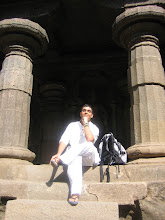I slowly began to explore these sutras and almost immediately I knew that I was dealing with a whole different kind of sutra. Stylistically and doctrinally, many Mahayana sutras are completely different from the Pali texts I was used to. It took a while for me to figure a way in which to constructively approach them.
During this time, I had been reading a book well known to many who share an interest in Eastern spirituality and science: The Tao of Physics. This book fascinated me on so many levels but the one thing that I found particularly striking was Frijof Capra's explanations of reality being an interpenetrating phenomenon, best illustrated by the famous metaphor of Indra's Net. Alan Watts provides a concise and elegant explanation:
Imagine a multidimensional spider's web in the early morning covered with dew drops. And every dew drop contains the reflection of all the other dew drops. And, in each reflected dew drop, the reflections of all the other dew drops in that reflection. And so ad infinitum. That is the Buddhist conception of the universe in an image.Or in the words of William Blake:
To see a World in a Grain of SandWow. Amazing. Beyond amazing. I had never heard of anything even remotely close to this before in my life. I'd always been a dreamer as a kid, looking up at the dozen or so stars visible in
And a Heaven in a Wild Flower,
Hold Infinity in the palm of your hand
And Eternity in an hour.
 the New York City nights and contemplating my tiny but special place in the universe. This however, just totally made my head explode. The source material for this, as Capra repeatedly referenced was actually a Mahayana Buddhist text called the Avataṃsaka Sutra (अवतंसक सूत्र, 華嚴經), translated as the Flower Adornment (or Ornament) Scripture. Up until this point, my exploration of Mahayana sutras was rather aimless, drifting from here to there but now I had a target and my sights were set. I couldn't believe that there were sutras which talked about this...apparently in excessive detail. I had to read this and I had to know more.
the New York City nights and contemplating my tiny but special place in the universe. This however, just totally made my head explode. The source material for this, as Capra repeatedly referenced was actually a Mahayana Buddhist text called the Avataṃsaka Sutra (अवतंसक सूत्र, 華嚴經), translated as the Flower Adornment (or Ornament) Scripture. Up until this point, my exploration of Mahayana sutras was rather aimless, drifting from here to there but now I had a target and my sights were set. I couldn't believe that there were sutras which talked about this...apparently in excessive detail. I had to read this and I had to know more.After some searching around, I discovered some peculiar particulars about the Avataṃsaka. The sutra as it comes down to us now is actually a compendium of various smaller sutras. The almost all of the original Sanskrit text has been lost with the sutra being preserved in Chinese and Tibetan translation. Two of the Sanskrit chapters have survived and they are arguable the most popular and influential parts; the Ten Grounds (Daśabhūmika - दशभूमिक) and Entry into the Inconceivable (Gandavyuha - गन्दव्यूह) chapters. The Ten Grounds chapter focuses on the stages of the Bodhisattva Path that lead up to enlightenment while the Entry Into the Inconceivable details the journey of the spiritual pilgrim Sudhana as he visits various teachers in his quest for Awakening.
The Avataṃsaka is nicknamed by some as the "King of Sutras", not only because it is the longest text but also because of the grand scope of its teachings. D.T. Suzuki (as quoted by Thomas Cleary) writes of it:
As to the Avatamsaka-Sutra, it really is the consummation of Buddhist thought, Buddhist sentiment, and Buddhist experience. To my mind, no religious literature in the world can ever approach the grandeur of conception, the depth of feeling, and the gigantic scale of composition as attained by this sutra. Here not only deeply speculative minds find satisfaction, but humble spirits and heavily oppressed hearts, too, will have their burdens lightened. Abstract truths are so concretely, so symbolically represented here that one will come to realization of the truth that even in a particle of dust, the whole universe is seen reflected - not this visible universe only, but vast systems of universes, conceivable by the highest minds only.Suzuki's wondrous, if somewhat intimidating view, also points to another interesting tidbit about the sutra: it remains a little known, obscure text in Western Buddhism. The reasons for this are not hard to understand. The sutra's length and complexity alone are enough to dissuade many translators. Indeed, there's only one complete English translation of the sutra out there, the one by Thomas Cleary. Aside from this, the Buddhist Text Translation Society has published some translations of small bits of the sutra but these are currently being revised - a fresh and complete translation of the Ten Grounds is currently in the works.
Still determined to check out this text, I picked up a copy of Cleary's translation, opened it up, and became another one of the countless practitioners who would be (in a positive way) be totally blown away...








No comments:
Post a Comment